Diabetes mellitus induces bone marrow microangiopathy
- PMID: 20042708
- PMCID: PMC3548136
- DOI: 10.1161/ATVBAHA.109.200154
Diabetes mellitus induces bone marrow microangiopathy
Abstract
Objective: The impact of diabetes on the bone marrow (BM) microenvironment was not adequately explored. We investigated whether diabetes induces microvascular remodeling with negative consequence for BM homeostasis.
Methods and results: We found profound structural alterations in BM from mice with type 1 diabetes with depletion of the hematopoietic component and fatty degeneration. Blood flow (fluorescent microspheres) and microvascular density (immunohistochemistry) were remarkably reduced. Flow cytometry verified the depletion of MECA-32(+) endothelial cells. Cultured endothelial cells from BM of diabetic mice showed higher levels of oxidative stress, increased activity of the senescence marker beta-galactosidase, reduced migratory and network-formation capacities, and increased permeability and adhesiveness to BM mononuclear cells. Flow cytometry analysis of lineage(-) c-Kit(+) Sca-1(+) cell distribution along an in vivo Hoechst-33342 dye perfusion gradient documented that diabetes depletes lineage(-) c-Kit(+) Sca-1(+) cells predominantly in the low-perfused part of the marrow. Cell depletion was associated to increased oxidative stress, DNA damage, and activation of apoptosis. Boosting the antioxidative pentose phosphate pathway by benfotiamine supplementation prevented microangiopathy, hypoperfusion, and lineage(-) c-Kit(+) Sca-1(+) cell depletion.
Conclusions: We provide novel evidence for the presence of microangiopathy impinging on the integrity of diabetic BM. These discoveries offer the framework for mechanistic solutions of BM dysfunction in diabetes.
Figures
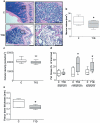
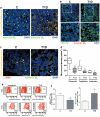
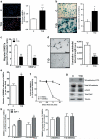
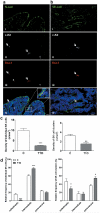


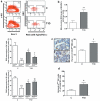
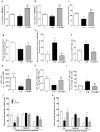
Similar articles
-
Diabetes causes bone marrow endothelial barrier dysfunction by activation of the RhoA-Rho-associated kinase signaling pathway.Arterioscler Thromb Vasc Biol. 2013 Mar;33(3):555-64. doi: 10.1161/ATVBAHA.112.300424. Epub 2013 Jan 10. Arterioscler Thromb Vasc Biol. 2013. PMID: 23307872 Free PMC article.
-
Boosting the pentose phosphate pathway restores cardiac progenitor cell availability in diabetes.Cardiovasc Res. 2013 Jan 1;97(1):55-65. doi: 10.1093/cvr/cvs291. Epub 2012 Sep 20. Cardiovasc Res. 2013. PMID: 22997160 Free PMC article.
-
Glyoxalase-1 overexpression in bone marrow cells reverses defective neovascularization in STZ-induced diabetic mice.Cardiovasc Res. 2014 Feb 1;101(2):306-16. doi: 10.1093/cvr/cvt259. Epub 2013 Nov 20. Cardiovasc Res. 2014. PMID: 24259499
-
[Endothelial function and the microcirculation in diabetes mellitus].Ann Ital Med Int. 1999 Apr-Jun;14(2):106-13. Ann Ital Med Int. 1999. PMID: 10399372 Review. Italian.
-
Reactive oxygen species adversely impacts bone marrow microenvironment in diabetes.Antioxid Redox Signal. 2014 Oct 10;21(11):1620-33. doi: 10.1089/ars.2014.5944. Antioxid Redox Signal. 2014. PMID: 25089632 Free PMC article. Review.
Cited by
-
Redox regulation of stem/progenitor cells and bone marrow niche.Free Radic Biol Med. 2013 Jan;54:26-39. doi: 10.1016/j.freeradbiomed.2012.10.532. Epub 2012 Oct 17. Free Radic Biol Med. 2013. PMID: 23085514 Free PMC article. Review.
-
Impaired endothelial progenitor cell mobilization and dysfunctional bone marrow stroma in diabetes mellitus.PLoS One. 2013;8(3):e60357. doi: 10.1371/journal.pone.0060357. Epub 2013 Mar 28. PLoS One. 2013. PMID: 23555959 Free PMC article.
-
Microvascular permeability and texture analysis of bone marrow in diabetic rabbits with critical limb ischemia based on dynamic contrast-enhanced magnetic resonance imaging.J Diabetes Investig. 2024 May;15(5):584-593. doi: 10.1111/jdi.14145. Epub 2024 Jan 19. J Diabetes Investig. 2024. PMID: 38240456 Free PMC article.
-
Myeloid cell contributions to cardiovascular health and disease.Nat Med. 2018 Jun;24(6):711-720. doi: 10.1038/s41591-018-0064-0. Epub 2018 Jun 4. Nat Med. 2018. PMID: 29867229 Free PMC article. Review.
-
Switch from canonical to noncanonical Wnt signaling mediates high glucose-induced adipogenesis.Stem Cells. 2014 Jun;32(6):1649-60. doi: 10.1002/stem.1659. Stem Cells. 2014. PMID: 24496952 Free PMC article.
References
-
- Asahara T, Kawamoto A. Endothelial progenitor cells for postnatal vasculogenesis. Am J Physiol Cell Physiol. 2004;287:C572–579. - PubMed
-
- Dimmeler S. ATVB in focus: novel mediators and mechanisms in angiogenesis and vasculogenesis. Arterioscler Thromb Vasc Biol. 2005;25:2245. - PubMed
-
- Fischer C, Schneider M, Carmeliet P. Principles and therapeutic implications of angiogenesis, vasculogenesis and arteriogenesis. Handb Exp Pharmacol. 2006:157–212. - PubMed
-
- Jin DK, Shido K, Kopp HG, Petit I, Shmelkov SV, Young LM, Hooper AT, Amano H, Avecilla ST, Heissig B, Hattori K, Zhang F, Hicklin DJ, Wu Y, Zhu Z, Dunn A, Salari H, Werb Z, Hackett NR, Crystal RG, Lyden D, Rafii S. Cytokine-mediated deployment of SDF-1 induces revascularization through recruitment of CXCR4+ hemangiocytes. Nat Med. 2006;12:557–567. - PMC - PubMed
-
- Calvi LM, Adams GB, Weibrecht KW, Weber JM, Olson DP, Knight MC, Martin RP, Schipani E, Divieti P, Bringhurst FR, Milner LA, Kronenberg HM, Scadden DT. Osteoblastic cells regulate the haematopoietic stem cell niche. Nature. 2003;425:841–846. - PubMed
Publication types
MeSH terms
Substances
Grants and funding
LinkOut - more resources
Full Text Sources
Research Materials

